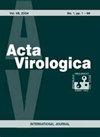高温灭活是一种对抗由空气传播的病原体引起的感染的方法
IF 0.8
4区 医学
Q4 VIROLOGY
引用次数: 0
摘要
当前严重急性呼吸系统综合征冠状病毒2型感染的大流行凸显了控制措施对抗空气传播病原体引起的感染的重要性。非特异性作用包括通过针对给定病原体的结构成分的化学或物理方法使微生物失活的各种手段。将病毒和细菌暴露在高温下是释放其有害潜能的有效方法之一。使用暴露于高温下的人类腺病毒5的模型,随后在A549细胞中对病毒进行体外滴定,我们发现在超过100°C的温度下热处理5 s后,病毒滴度显著降低。为了验证在封闭环境中热灭活的潜力,构建并测试了高容量病原体清洁装置的原型。在226立方米的房间中以900立方米/小时的气流速度应用该装置2小时,使房间中所有收集点的空气中微生物总数减少了50%以上。本文章由计算机程序翻译,如有差异,请以英文原文为准。
Heat inactivation by high temperature as an approach to combat infections caused by airborne pathogens
The current pandemic of SARS-CoV-2 coronavirus infection has highlighted the importance of control measures to combat infections caused by airborne pathogens. Non-specific actions include various means of microorganism inactivation by chemical or physical methods targeting structural components of a given pathogen. Exposure of viruses and bacteria to elevated temperatures is one of the effective methods for discharging their harmful potential. Using a model of the Human Adenovirus 5 exposed to elevated temperatures with subsequent titration of the virus in vitro in A549 cells, we showed a dramatic decrease of the virus titer after heat treatment for 5 s at temperatures over 100°C. To verify the potential of the heat inactivation in a closed environment, the prototype of a high-capacity pathogen-cleaning device was constructed and tested. Application of the device for 2 h at an airflow rate of 900 m3/h in a room of 226 m3 reduced the total number of microorganisms in the air by more than 50% at all collection sites in the room.
求助全文
通过发布文献求助,成功后即可免费获取论文全文。
去求助
来源期刊

Acta virologica
医学-病毒学
CiteScore
3.10
自引率
11.80%
发文量
43
审稿时长
>12 weeks
期刊介绍:
Acta virologica is an international journal of predominantly molecular and cellular virology. Acta virologica aims to publish papers reporting original results of fundamental and applied research mainly on human, animal and plant viruses at cellular and molecular level. As a matter of tradition, also rickettsiae are included. Areas of interest are virus structure and morphology, molecular biology of virus-cell interactions, molecular genetics of viruses, pathogenesis of viral diseases, viral immunology, vaccines, antiviral drugs and viral diagnostics.
 求助内容:
求助内容: 应助结果提醒方式:
应助结果提醒方式:


